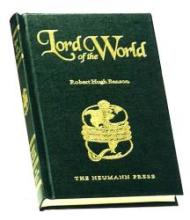Monsignor Robert Hugh Benson
Initiation
Set in aristocratic England of the late 19th century, this novel by a convert to Catholicism explores the concept of our participation in the Atonement. Young Sir Nevill Fanning is thoughtlessly and unconsciously pagan (though outwardly Catholic) and heir to his dear Aunt Ann's estate. Early on, he falls in love with a Protestant, and this raises various issues both within his aunt and within himself. A Mr. Morpeth represents the holiness and wisdom of the Church as Nevill and Ann work out their salvation.
The novel is at once a profound explanation and touching portrayal of intercessory prayer and atoning suffering, using the unique idiom of the novel, in which the author can create and then unfold an entire cast of characters. Psychological insights and matters of spiritual growth are magnified and clarified in the lens of story. For various reasons, I have recently read a lot of Jane Austen and Charlotte Bronte, and it is all the more interesting to enter into an English countryside world not too far removed from theirs in place or time, but very much removed in theological reach.
It would have been helpful if the publishers had included a table of contents. Several striking passages proved very hard to relocate. There is an extraordinarily sweet and insightful passage about people who see little "signs" in various things. (See Book 2, chapter V, section IV, or, page 261) Even the first passage about initiation, a thoughtful reflection on the difference between those who have come to accept what happens and those who have not, is very hard to find. It's on page 71, and it is clearly the prologue to the interior substance of the story.
Update April 2024: This book was donated for review by Lepanto Press; however, they no longer publish this work.
Originally published in 1914, it is still available from various re-publishers.
Lord of the World
The setting is a future society where the Catholic Church is no more than an embattled remnant. In the popular and intellectual view, culture has moved past the "need" for faith in the supernatural. Near the beginning of the book, two young priests discuss with their superior how to regain some Catholic foothold in a culture which has been de-sacramentalized; of the two, one goes over to the enemy's side, while the other will be hunted and scorned for his faith. The latter priest, Father Percy, a sort of focal point of the book, has the odd distinction of being physically almost identical to his counterpart, a mysterious international leader who has a more-than-human influence on the people he gathers around him. This anti-Christ figure is personable, not obviously evil, and seems in all ways more powerful than the fugitive priest - but as Christ's representative, Father Percy is ultimately victorious in the task he is called to carry out. Their physical resemblance seems to be a device to underline the contrast.
The contrast is also demonstrated in their respective influences on a married couple and the husband's mother, who are key characters in the book. The mother is drawn back towards the sacraments as she drifts closer to death while the attractive couple move from kind "tolerance" to active antagonism for the church and all it represents.
Modern humanitarian secularism eases into savage barbarism and the light of truth seems to flicker and die, but though the events are dark, the ending demonstrates that the battle has been won on a supernatural level even while lost by worldly standards.
I would probably save this book for an older high-schooler who is mature enough to distinguish between tenets of the faith and imaginative extrapolation. It might be quite interesting to read this book alongside some secular works in the same genre - Aldous Huxley's Brave New World, Orwell's 1984 and Animal Farm, or even some of the works of H.G. Wells. Another book written from a Catholic perspective, a science fiction post-apocalyptic classic from the 1950's, is Walter Miller's A Canticle for Leibowitz. One more book which deals with the effect of modernism on society is C.S. Lewis's That Hideous Strength, the last of his Space Trilogy. I could see these books being read as an introduction to modern worldviews in perhaps 11th or 12th grade.


